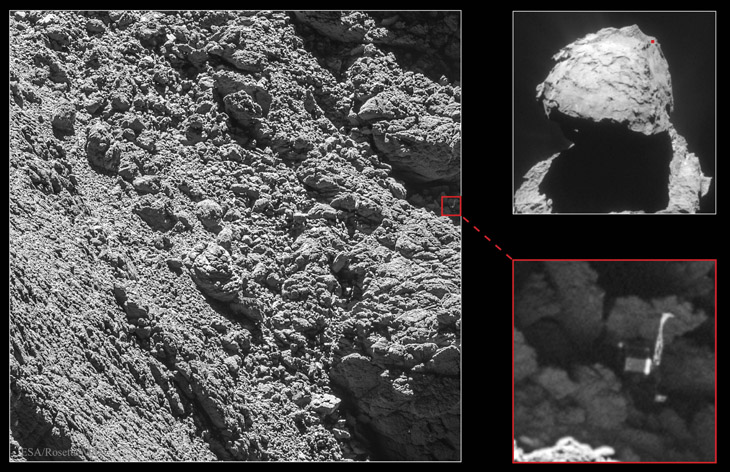
Courtesy of Astronomy Picture of the Day, we have actual images of the Philae lander in its resting place on Comet C67/P Churyumov-Gerasimenko, and you definitely will want to not only click on that link, but on the image therein to see the full-resolution version. If you recall, about 22 months ago, the washing-machine-sized lander was launched from its ‘mother ship,’ the Rosetta probe, to land directly on the surface of the comet. Only the anchoring systems failed to activate, and the lander bounced multiple times before coming to rest in an awkward and unknown location. This is not surprising when you know the physics of it; mass and weight are two different things, the latter being governed by gravity (itself a factor of mass.) The small size of the comet nucleus means it has a ridiculously low gravity to attract anything to its surface, so despite its size, Philae effectively weighed the same as 1/4 of a sheet of paper here on Earth. I’m not kidding – I’m actually exaggerating slightly. With hard materials and no wind resistance, it was able to bounce quite high under the impact of its own touchdown – according to an article on Universe Today, perhaps higher than 3 kilometers. Had it touched down any faster, it might simply have escaped into open space. And as can be seen from the photos, the chances of finding a smooth and ‘level’ landing spot were incredibly slim. A lot of this has to do, again, with the negligible mass of Churyumov-Gerasimenko; it simply doesn’t have the gravity to smooth out its very substrate. And of course, no wind, no rain, no disturbances of any kind (save for pesky landers) to cause anything to settle further. Much of this material is simply accumulation of dust and ice from space, captured in casual passing contact with the weak gravity of the nucleus.
There was no ability to witness the touchdown, either by video onboard Philae or remotely from Rosetta, so no one was quite sure what happened, but a lot could be inferred from the data that started coming back. For one, the batteries aboard Philae died quickly, meaning they were not being recharged by the surrounding solar panels, giving some indication that Philae had dropped into a shadowy area – this was later confirmed by one of the cameras getting photos of a massive overhang. By triangulating the signals as the comet turned and Rosetta kept pace, the rough area of Philae’s location could be determined. Eventually, it was spotted in shadow, awkwardly tipped onto its side. As that article from Universe Today shows, it is pointed to our left, one of its three legs highly visible at top, another very faintly visible by the end of its foot at lower right.
Or so they say – I’m always suspicious of photos where I have to be told what I’m seeing, but you’re welcome to compare the diagrams of Philae’s construction with the photo. To me, it looks a lot more like a broad-headed robot, with its back to us, climbing the rocks. And not an experienced one, either, because it’s blindly putting one hand up on top of a rock surface that it cannot see, always a bad move for climbers, because it might mean plopping a hand directly atop a snake basking on the rock. Sure, maybe most comets don’t host snakes with a venom that could be dangerous to robots, but is that a chance worth taking?

[By the way, I’ve looked over the full resolution image carefully, and I’m pretty sure I spotted some Jawas in there…]
















































